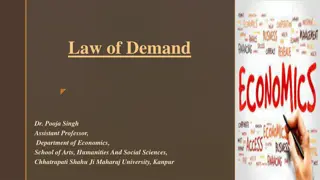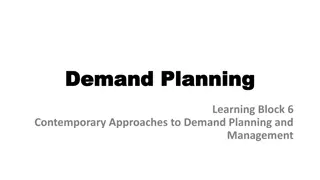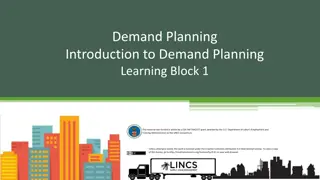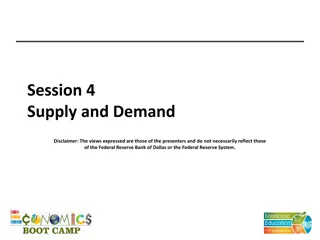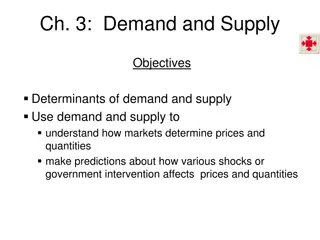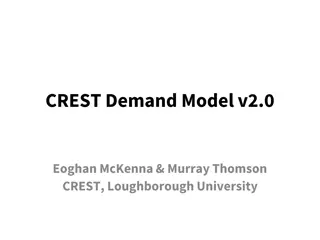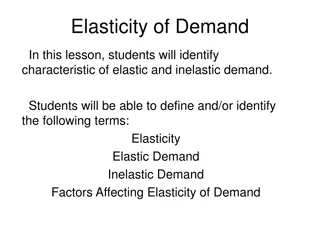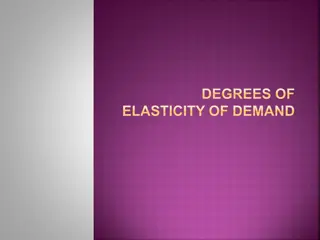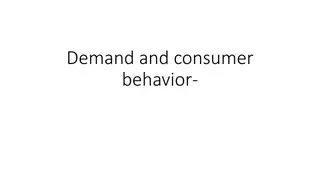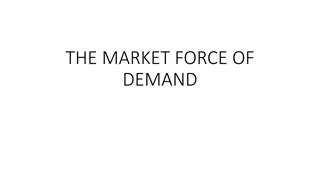Impact of Human vs. Systems Factors on Demand Planning Performance
Exploring the impact of human vs. systems factors on demand planning performance in supply chain management is crucial for achieving competitiveness. Effective planning is essential for coordination and execution of customer orders, but issues such as deviations from original plans and unnecessary interventions can compromise supply chain coordination, leading to negative effects on customer service delivery and overall competitiveness.
Download Presentation

Please find below an Image/Link to download the presentation.
The content on the website is provided AS IS for your information and personal use only. It may not be sold, licensed, or shared on other websites without obtaining consent from the author. Download presentation by click this link. If you encounter any issues during the download, it is possible that the publisher has removed the file from their server.
E N D
Presentation Transcript
Exploring the impact of human vs systems factors on demand planning performance Alexander Kharlamov; Janet Godsell; Ganna Pogrebna May 2016
About Lic. & MSc Industrial Management and Engineering (University of Aveiro) MSc in Management Research (Cranfield School of Management) Currently PhD in Engineering (WMG, Warwick University) Mostly case-based research, interested in operations and supply chain management, segmentation, analytics, and behaviour. 2
Summary Background: Importance and Problem Underpinning Theory Conceptual Framework Research Design Preliminary Findings Further work 3
The importance of planning in Supply Chain Management The ultimate goal of supply chain management (SCM) is competitiveness (Christopher, 2011) Competitiveness is realised by means of customer service which can be achieved by increased flexibility to changes in customer demands, superior quality of products and services, or cost reduction (Christopher, 2011) The success of SCM greatly depends on (Lee & Ng, 1998, p.1) Integration of the network of organisations Coordination of information, material and financial flows. Planning is essential for coordination and execution of customer orders Planning concerns purchasing, production and distribution, as well as ensuring availability of materials, personnel, machinery and tools Planning can be defined as: The preparation for decisions and actions in relation to a time horizon with different levels of importance (Fleischmann et al. 2015) 4
The problem with planning in SCM Planning is essential for Supply Chain coordination However, in practice, planners show relatively little adherence to the original plan (Harrison, 1997) Planners systematically disregard the forecasts (even though its often accurate) through the We know best syndrome (Mason-Jones & Towill, 1998, p.19) After the plan is set, planners often intervene and make changes due to mistrust, second guessing, over-reactions and fear of losing sales (Niranjan et al., 2009) Unnecessary interventions with the plan often have negative effects on the whole SC (Niranjan et al., 2009) Amplification of small variations (over-reactions and distorted information) e.g. Forrester effect (Forrester, 1958) also known as bullwhip effect (Lee et al., 1997) Hoarding and Phantom ordering (Sterman and Dogan, 2015) Extra costs e.g. inventory, markdowns, stock-outs or obsolescence (e.g. Niranjan et al., 2009) The negative effects on the SC caused by unnecessary interventions with the plan compromise SC coordination and consequently SC s ability to deliver customer service and achieve competitiveness. 5
Underpinning theory Myopic Loss Aversion (e.g. Thaler et al., 1997) Loss Aversion The tendency to weight losses heavier than equivalent gains Mental Accounting (Gneezy & Potters, 1997) The tendency to evaluate outcomes more frequently Trait theory of personality Personality is the set of psychological traits and mechanisms within the individual that are organized and relatively enduring and that influence his or her interactions with, and adaptations to, the intrapsychic, physical, and social environments. (Larsen & Buss, 2010, p.4) 6
Conceptual Framework System (Policy) (Mason-Jones & Towill, 1998) (Simpson, 1999; Zhao & Lee, 1993 de Kok & Inderfurth, 1997) Contribution (Lapide, 2007 Pervin, 1994 Larsen & Buss, 2010 Sterman and Dogan, 2015) Planning Performance Individual Characteristics Bias MLA Contribution Mental Accounting (evaluation periods) Contribution Loss Aversion Assumption for everybody (Carter et al., 2007; Tokar, 2010; Sterman & Dogan, 2015 Childerhouse et al., 2003a) Individual (Thaler et al., 1997 (Gneezy & Potters, 1997) 7
Research Design Experiments in form of a voluntary survey Three experiments on three different samples Each with three treatments for the planning task (Short, Long, Hybrid) Sample (total N=354): (Laboratory experiment) Baseline (total N=270) Na ve Students Incentivised (average pay of 10), N= 110 (incentive proportional to planning performance) Baseline Na ve Students non-Incentivised, N= 160 (Field experiment) Professional Planners N=84 Results analysed using econometric methodology Comparison between laboratory and field experiments following the approach proposed by Haigh and List (2005) 8
The Planning Task Treatments Planning task: Modified Newsvendor Problem Each participant makes 30 planning decisions after 9 practice rounds Visual and numeric feedback 1) Short Commitment ? ? ? ? ? ? ? ? ? ? ? ? ? Planning Periods Three treatments: 1. 2. 3. Note: Participants are assigned randomly to a treatment when they start the experiment Priming: Recommended planned quantity Participants were primed with the optimum order volume for the given problem without knowing that it s the optimum 2) Long Commitment Short Commitment Long Commitment Hybrid Commitment ? = = ? = = ? = = ? = = ? Planning Periods 3) Hybrid Commitment ? ? ? ? ? ? ? ? ? ? ? ? ? Planning Periods 9
Planning task interface Initial settings and priming Numeric decision feedback Decision instructions and input, different between treatments Interactive graphical and numeric decision feedback and history 10
Questionnaire BIG 5 Personality Inventory: Mini-IPIP - Mini International Personality Item Pool (Donnellan et al., 2006) Psychometric scales: BIS - Barratt Impulsiveness Scale (Patton et al., 1995) EPO - Elaboration on Potential Outcomes (Nenkov et al., 2008) GDMS - General Decision Making Style (Scott & Bruce, 1995) Demographic questions Gender/Age/Role Background education (for students) Context Specific Questions for Professional Planners Sector (for professional planners) Experience in Planning Professional Membership Definition of planning 11
Preliminary Results MLA is detected across all groups, i.e. better performance observed with strict policy forcing longer commitment to the plan for students and professionals Performance between na ve students and professionals has no significant difference across all treatments System (policy) overrides personality characteristics Personality is partially significant when planners have to choose (flexible policy) In general, traits related to overthinking are associated to worse performance 12
Further work (apart from writing up the thesis) Small margin newsvendor treatment Modified Beer Game with professionals 13
Thank you! Contact: a.a.Kharlamov@warwick.ac.uk





